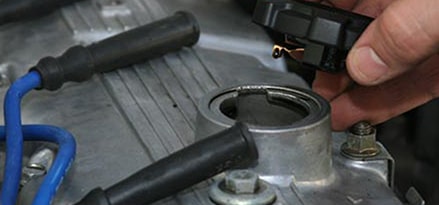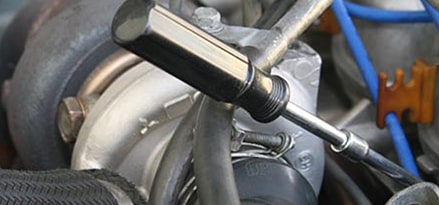By Mike Bumbeck, automedia.com
Difficulty: Moderate
Estimated time: 120 minutes
An internal combustion engine makes power by first drawing air and fuel into the combustion chamber. Next is the compression of the mixture and the addition of a spark. The harnessing of the resulting contained explosion is ultimately what powers the car. As an engine gets on in miles, the containment of this power can be lost due to piston ring, valve or cylinder wall wear. Engine performance will suffer as a result.
Pressure reading
A common test of an engine’s ability to compress the air-fuel mixture is an
engine compression test. A pressure gauge is connected in place of the
spark plug. The engine is then cranked to create a pressure reading. A
compression test is a good way to check the engine’s ability to create
pressure. The gauge reads the positive pressure created by the cylinder.
Loss reading
An engine leakdown test is a compression test in reverse. Instead of
measuring the engine’s ability to create pressure, compressed air is
introduced into the cylinder through the spark plug hole. One gauge on the
tester measures the pressure of the air entering the cylinder and the other
measures the percentage of the air escaping (or leaking) from the cylinder.
The loss percentage will indicate the condition of the cylinder and overall
condition of the engine.
Top dead center
Before sending air into the engine, the cylinder being tested must be
placed at Top Dead Center (TDC). The piston must be at the top of its
travel. The intake and exhaust valves must be closed. When the air is
compressed into the cylinder, the leakdown tester will measure any loss of
air escaping past valves or piston rings. If the cylinder is not at TDC,
air escaping past an open valve will give a false reading.
Reading results
No engine will have perfect sealing with 0 percent loss. Five to 10 percent
loss indicates an engine in great to good running order. An engine between
10 and 20 percent can still run OK, but it’ll be time to keep an eye (or
ear) on things. Above 20 percent loss and it may be time for a teardown and
rebuild. Thirty percent? Major problems. The percent of leakage should also
be consistent across the cylinders. Any great differences indicate a
problem in that cylinder.
Hearing problems
Beyond getting an overall picture of engine condition, the engine leakdown
test is an excellent way to pinpoint where problems are before tearing down
the engine. Listening for where the air is escaping by ear can isolate the
problem.
- Intake valve : Air whistling out of the intake, carburetor or throttle body indicates a leak at the intake valve.
- Exhaust valve : Air heard hissing out of the tailpipe, turbocharger or exhaust manifold means an exhaust valve leak.
- Piston rings : Whistling or hissing out of the PCV valve, oil filler cap hole or dipstick tube means the air is pushing past the rings. Suspect ring or cylinder wall wear.
- Head gasket : Air bubbles in engine coolant seen at the radiator filler cap could mean air escaping into the coolant past the head gasket.
- Cracked cylinder head : Bubbles in coolant or coolant being pushed up out of the radiator neck can also indicate cracks in the cylinder head or cylinder walls.
Tools, supplies and instructions
You will need a compressed air source, a leakdown gauge kit, spark plug
socket, basic hand tools, vehicle service manual and a notepad to record
results.

Step 1 : Remove the spark plugs and rotate the engine to put the cylinder to be tested at TDC. Tip: Insert a long screwdriver or extension into the spark plug hole and turn the engine by hand with a socket on the crankshaft. When the screwdriver stops rising or falling, you’re at TDC. Don’t turn the engine backward if TDC is missed. Go around again. In a four-cylinder engine, cylinders one and four and two and three are at TDC at the same time.

Step 2 : Figure out which spark plug adapter works best and connect the gauge into the hole. Put the vehicle in gear and set the parking brake to prevent the engine from turning when air is compressed into the cylinder. Start with the regulator turned counterclockwise to zero the incoming pressure. Connect compressed air. Turn the regulator clockwise to pressurize air into the cylinder.

Step 3 : Record leakage percentage for the cylinder. Remove the oil dipstick, radiator cap and oil filler cap. Open the throttle body or remove the air cleaner. Listen and watch. Wherever air is escaping will indicate where the problem is. Disconnect the gauge and move to the next cylinder.

